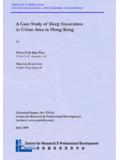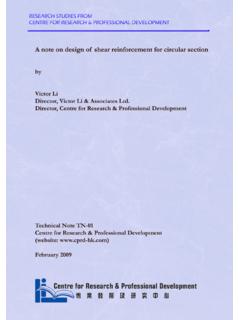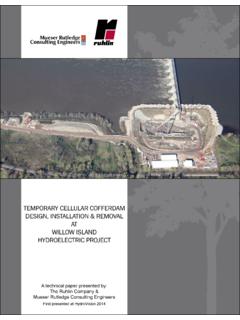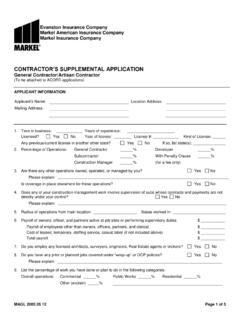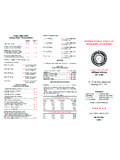Transcription of A discussion on the design of U-type sheet piles for ...
1 A discussion on the design of U-type sheet piles for cofferdamsVictor LiDirectorVictor Li & Associates LtdSheetpiles commonly used for supporting deep excavations in Hong KongCommon types of Sheetpiles U-type sheetpiles Z-type sheetpile Hat-type sheetpiles Lam (2010)Lam (2010)Basic Beam TheoryLam (2010) Implication: Max. shear occurs at mid-point U-type sheetpile may not act a fully composite section due to possible joint slippage Fully uncoupled U-type sheetpile (frictionless joint) Lam (2010) Comparison for U-type sheetpile (cm3/m)Zxx (cm3/m)EI (cm3/m)Zxx (cm3/m)Smooth jointFully composite sectionSheetpileMethod for Enhancing Shear Resistance of Interlock Technique Crimping (in factory) Welding (on site or in factory) Crimped/welded doubles (source: ArcelorMittal brochure)(source.)
2 ArcelorMittal catalog) Crimped/welded triples can be treated as fully composite section Continuous wallu u c c c c Triple Uu Continuous wall ( B= 100%)Single U ( B= 30 to 50%)Double U ( B= 60 to 80%)Triple U ( B= 95 to 100%)(Kort, 2004) u u u u u u u u u u c c c u u c c c c u Problems with crimping/pre-welding connected sheetpiles becomes wider more difficult to handle and install more vibration shortage of experienced welders Code Recommendations Reduction factor to moment capacity.
3 B M = BZ fywhere Z = section modulus for fully composite section Reduction factor to wall stiffness, w I = DIowhere Io= second area of moment for fully composite section BS EN 1993-5:2007 National Annex Recommendations Additional enhancement (limited to ) interlock not treated with sealant or lubricant: Bup Dup welding at wall top before BFavourable conditionsUnfavourable conditionsHighly unfavourable conditionsReduction factor500> to to to to weld length (mm)Depth of excavation (m) Example 1: Uncrimped sheetpile Favourable condition, > 1 layer of strut no sealant or lubricant no crimping or pre-welding B = + = D= + = If welding at top also carried out: B= + + = (take )or B= + = (?)
4 ?) D= + + = or D= + = (??)Implication on DesignTraditionally, B= D= 1 used for design for decades. Worked example 1: 6m deep excavation (fully composite) (welding at top) (no treatment) (fully composite) (welding at top) (no treatment)150 FSPIII (fully composite) (welding at top) (no treatment)120 FSPII Wall deflection(mm) DUnit weight (kg/m3)SheetpileIn all case, bending moment not critical. Worked example 2 : 12m deep excavation 1131 (fully composite) (welding at top) (no treatment) (fully composite) (welding at top) (no treatment)150 FSPIII (fully composite) (welding at top) (yielded) (no treatment)120 FSPII wall deflection (mm) Dunit weight (kg/m3)Sheetpile Findings: Upgrade one sheetpile size to achieve similar wall deflection if no special treatment is intended Increase weight (waste?
5 By about 25%Experimental Results : most experiments performed using unfilled joint with no applied pressure presence of earth pressure and soil infill in joints increases shear resistance of interlock Hence, reduction factor not realistic Experiments by Mawer & Byfield (2010)Bending Stress Comments Even Byfield s experiment not realistic enough Sands in interlocks pulverized and jam-pack the interlock during driving, causing significant locked-in stress and frictional resistance connections of struts/waling to sheetpile restrain sheetpile movement fusing of steel during drivingA Field Experiment Findings.
6 No noticeable relative movement of sheetpiles Slippage not a problemFinal Remarks Deficiency of theoretical and experimental studies leads to conservative reduction factors design based on fully composite sheetpiles used for decades in Hong Kong without much problem. Interlock slippage seldom observed in reality due to various enhancement factors earth pressure and hence friction sand filling and hence more friction( = or = 59o reported by Mawer & Byfield, 2010) - friction up to 80 kN/m reported horizontal and vertical restraint by waling, brackets and short stud jamming due to deviation from verticality restrain of vertical movement by long embedment depth design controlled by settlement.
7 Stability usually not an issue. design for cofferdam is already very conservative in Hong Kong. Use of reduction lead to even more conservative design No reduction factor needed generally when U-type sheetpiles driven in sand to avoid wastage of natural resources If reduction factor is to be applied: Current practice: B, D 1, B> D. Suggested practice: B 1, W 1with contingency measure to weld interlocks when slippage observed during excavation References: Kort, A. (2004). On the Use of Z and U piles .
8 Presentation at NSF-NGF meeting. ( ) Lam, J. (2010). The Use of Hat-Type Sheetpiles in Hong Kong , HKIE Geotechnical Division Annual Seminar Geotechnical Aspects of Deep Excavation, 61-66. Mawer, and Byfield, (2010). Reduced modulus action in U-section steel sheet pile retaining walls , Journal of Geotechnical and Geoenvironmental Engineering ASCE, Vol. 136, , 439 444.
